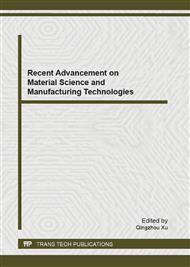[1]
J. E. Master, et al. Impact Fracture and Failure Suppression Using Interleaved Composites. SAMPE Quarterly. 17 (1985) 46-49.
Google Scholar
[2]
Jiao Guiqiong, Ning Rongchang, et al. A Study on Interleaved Composites (In Chinese). Aerospace Materials & Technology. 4 (2001) 36-39.
Google Scholar
[3]
S Zang, M A Hoisington, and J C Seferis. Particulate Interlayer Toughening of Dicyanate Matrix Composites. Polymer Composites. 14 (1993) 458-466.
DOI: 10.1002/pc.750140603
Google Scholar
[4]
Gao Feng, Jiao Guiqiong, et al. Mode II Fracture Toughness of Thermoplastic-Particle Interlayered Composite Laminate (In Chinese). Journal of Northwestern Polytechnical University. 23 (2005) 184-188.
Google Scholar
[5]
M. B. Dow, H. B. Dexter. Development of Stitched, Braided and Woven Composite Structures in the ACT Program and at Langley Research Center (1985 to 1997). NASA/TP-97-206234.
Google Scholar
[6]
Cheng Xiaoquan, A Al-Mansour, et al. Compression Strength of Stitched Laminates After Low Velocity Impact. Journal of Reinforced Plastics and Composites. 24 (2005) 935-947.
DOI: 10.1177/0731684405048193
Google Scholar
[7]
R. Velmurugan, S. Solaimurugan. Improvements in Mode I Interlaminar Fracture Toughness and In-plane Mechanical Properties of Stitched Glass/Polyester Composites. Composites Science and Technology. 67 (2007) 61-69.
DOI: 10.1016/j.compscitech.2006.03.032
Google Scholar
[8]
G. Freitas, C. Magee, et al. Fiber Insertion Process for Improved Damage Tolerance in Aircraft Laminates. Journal Advanced Materials. 25 (1994) 36-43.
Google Scholar
[9]
I. K. Partridge, D. D. R. Cartié. Delamination Resistant Laminates by Z-fiber Pinning I: Manufacture and Fracture Performance. Composites Part A. 36 (2005) 55-64.
DOI: 10.1016/s1359-835x(04)00180-0
Google Scholar
[10]
Wenyi Yan, Hong-Yuan Liu, Yiu-Wing Mai. Numerical Study on the Mode I Delamination Toughness of Z-pinned Laminates. Composites Science and Technology. 63 (2003) 1481-1493.
DOI: 10.1016/s0266-3538(03)00167-2
Google Scholar
[11]
Wenyi Yan, Hong-Yuan Liu, Y-W Mai. Mode II Delamination Toughness of Z-pinned Laminates. Composites Science and Technology. 64 (2004) 1937-1945.
DOI: 10.1016/j.compscitech.2004.02.008
Google Scholar
[12]
A.P. Mouritz. Review of Z-pinned Composite Laminates. Composites: Part A. 38 (2007) 2383–2397.
DOI: 10.1016/j.compositesa.2007.08.016
Google Scholar


